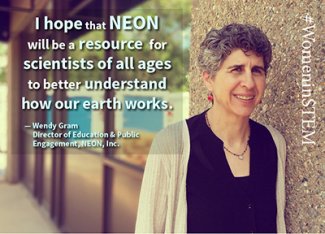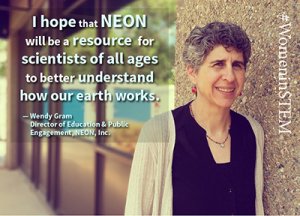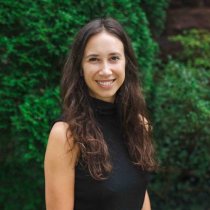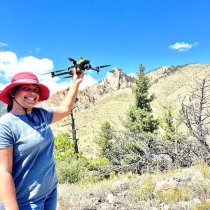Spotlight
Wendy Gram on why she's passionate about sharing science
July 10, 2015
Wendy’s team is responsible for engaging a wide variety of communities in using continental-scale data. Some of NEON’s educational programs and resources include NEON’s:
- Undergraduate Research Internship program, designed to provide students with Science, Technology, Engineering, and Mathematics (STEM) career experiences
- Data Tutorials, a series of online tutorials for learning and teaching big data analysis skills
- Project BudBurst, a citizen science program for collecting plant phenology observations (operated by the Chicago Botanical Gardens as of December 2016)
- Citizen Science Academy, online professional development courses for incorporating citizen science programs into educational programs (operated by the Chicago Botanical Gardens as of December 2016)
Give us some highlights about the Education and Public Engagement team at NEON?
First of all, the best part of my job is working with a great team of people. Together, we work on various ways to empower and engage people to use NEON. Everything from creating educational resources for people to use NEON science and data products to citizen science programs like Project BudBurst, which provides a platform for regular “citizen scientists” from all walks of life to collect and contribute their own observational data to NEON. I hope that NEON data will be a resource for scientists of all ages as they investigate how our earth works and how to maintain our ecosystems’ health for future generations.
Are you working on anything cool right now?
I love doing science and want to share that passion with as many people as possible. One idea I’m pursuing is to get NEON data to more people through partnerships with museums. In fact, I’m currently in discussions with several science museums about creative ways to weave data into museum exhibits. I would love to see an educational “game” installation where visitors can virtually “travel” to different NEON sites, evaluate some of the available data from that site, and “solve” science challenges based on those data.
What inspires you to work for NEON?
NEON’s mission to enable science and empowering people to work with data.
Did you always know you were interested in STEM?
I was always drawn to science and math in school but I was especially intrigued by “discovering” plants, bugs, birds, rocks and other parts of our natural world as a kid. I loved outdoor adventures for both the adventure and discovery parts. In college, I thought that I’d become a doctor but was instead drawn to ecology courses because I loved the stories about learning how the world works.
Which parts of STEM are relevant to what you do?
Science, technology and math
What relevant STEM schooling have you had?
BA Biology, PhD Ecology & Evolution
Any words of wisdom for girls or young women about STEM careers/schooling?
Always keep your options open by taking as much math and science as you possibly can – you’ll be surprised how much it might be a part of whatever you choose as a profession down the road.

Wendy Gram
About the NEON #WomeninSTEM series
According to U.S. Census Bureau statistics, women in fields commonly referred to as STEM (science, technology, engineering, mathematics) made up only 25 percent of the STEM workforce in 2011. However, women earn more college and graduate degrees than men, and they make up half the national workforce. So, why aren't more women going into STEM careers? In this series of interviews of staff at National Ecological Observatory Network (NEON), we will feature some of the amazing female STEM professionals at NEON and ask them to talk about how they found their way into the world of STEM and what words of advice they have to give the next generation of girls in STEM.
Wendy is just one of the many amazing STEM professionals that work at NEON. This series of staff spotlights will hopefully give women and girls some insight and inspiration about what it is like to be a STEM professional. NEON STEM-related positions include engineers, scientists, educators, computer scientists, system engineers and more. To learn about current career opportunities, visit our Careers page. NEON also offers an annual summer internship program to give qualified undergraduates the opportunity to gain work experience in an interdisciplinary STEM environment.



